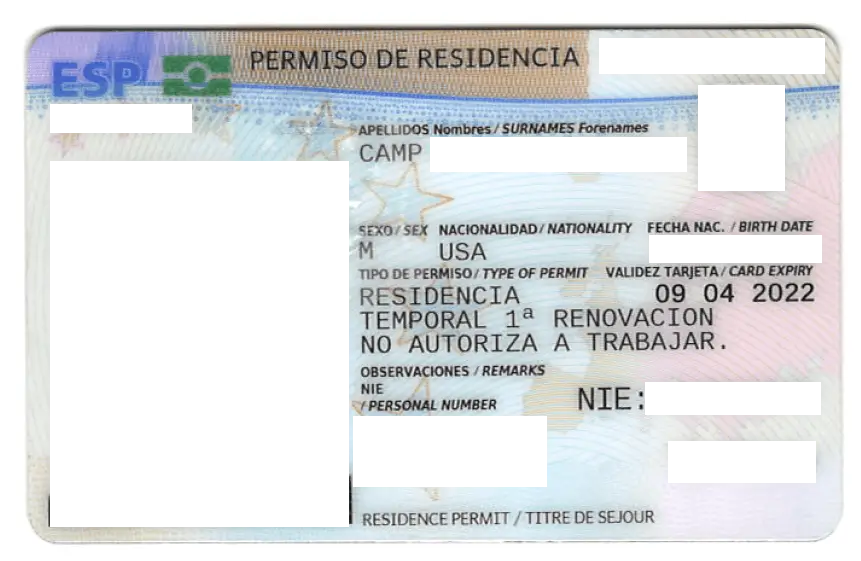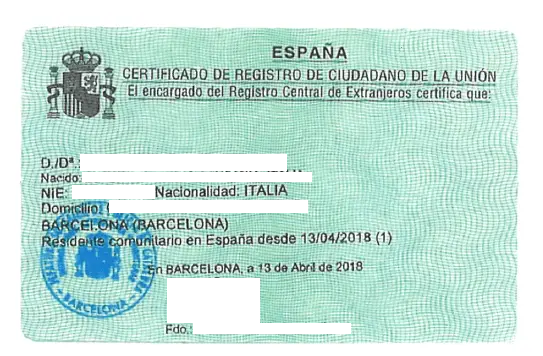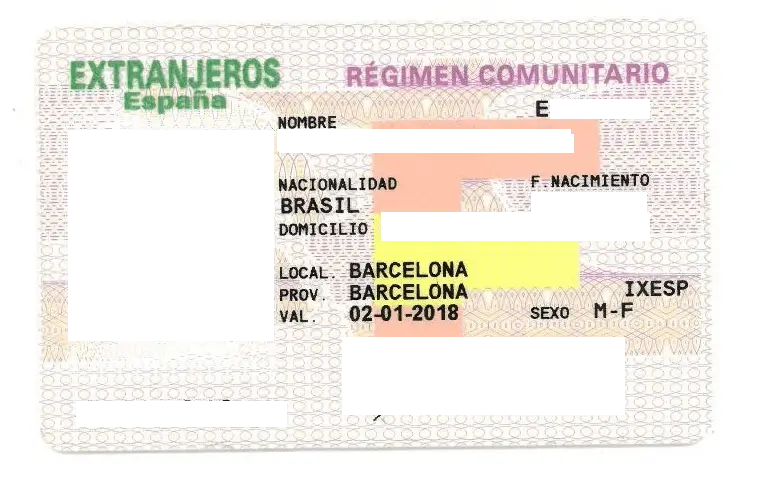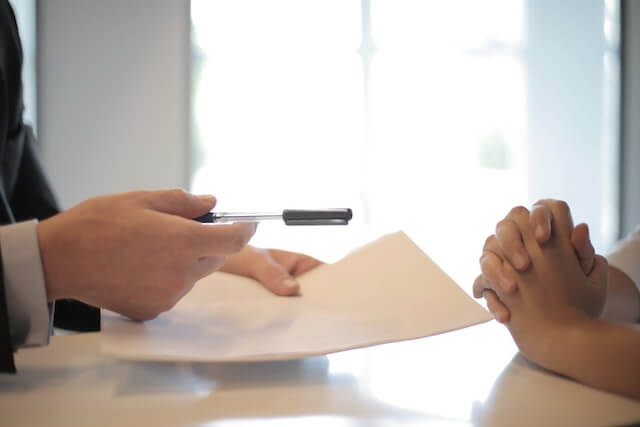NIE and TIE are two different documents that are often mismatched or confused. If you are a foreigner thinking of investing in Spain or going to live there, you have probably already heard of these and are looking for some clarification on the matter. In this article we are going to explain the difference between NIE and TIE, the distinct types of each one (NIE number and TIE card, green card, and blue and pink one) and which one you should get depending in your specific case.
Here you can find a summary of the article and the links to go directly to the answer you are looking for:

- NIE number refers to the number assigned to all foreigners that have some legal matters in Spain. NIE stands for “número de identidad del extranjero” – Foreigner’s Identification Number. Every foreigner who has any legal paperwork to do in Spain needs to get it, whether you live there or not: the NIE is also your Spanish tax identification number. It is issued on a white sheet of paper A4 size.
- TIE Card – for Non-EU nationals residents – is a card all non-EU foreign residents must receive in Spain if they live here for more than 6 months. TIE stands for “tarjeta de identidad del extranjero” – Foreigner’s Identification Card. You can only get a TIE if you are a resident in Spain and will live here for more than 6 months. Your NIE number will appear on it.
- Green card (NIE) – for EU nationals residents – NIE is also commonly referred to the little green card issued to EU passport holders. The NIE card has your Foreigner’s Identification Number but doesn’t have a photo on it and must always be accompanied by your national document to prove your identity. EU nationals do not need a TIE. Family members or dependents of EU passport holders get a TIE.
NIE or TIE depending on your passport
Non-EU nationals: All foreigners need to get a NIE number to do paperwork in Spain. If you are going to live in Spain for more than 6 months, you need to apply for a TIE within 30 days of arriving in Spain.
EU nationals: All foreigners need to get a NIE number. If you are going to live in Spain, you can then apply for a green card.

NIE stands for Número de Identificación de Extranjero (identification number for foreigners) and is for everyone who isn’t a Spanish citizen. No matter which country you come from, EU or non EU, if you are a foreigner in Spain you will have a NIE.
NIE is always one letter followed by 7 numbers, and then another letter- e.g. X-1234567-B.
In short, it is just a number that identifies you as a foreigner in Spain. This number is required for any legal and financial work to file taxes, buy property, establish a business, open a bank account, and for almost all other official forms you fill out.
You need a NIE to make any kind of transaction or payment that might involve the Spanish Tax Office – so it is important that you have one for any kind of financial, professional, or social affair that you engage with in Spain. e.g., buy a property, open a business, buy a car, rent an apartment, pay electricity bills, telephone bills, register your child in school, make an investment, etc. Note that tax registration is not always automatic when you obtain your NIE at the Spanish police, and you may need to go to the Tax Office to “activate” it.
The NIE is not a proof of residence and does not authorize you to live or work in Spain, it’s just a number. Authorization for residence in Spain – for non EU nationals it’s the TIE, for EU citizens it’s the EU residency certificate (or green NIE card).
The NIE is not a proof of address, you will need a padrón for that. We explain below in this article how to get the padrón.
To apply for a NIE if you are legally present in Spain, you need to book an appointment at one of these Police Stations. It’s usually hard to get an appointment as Spanish police tends to be overloaded, so we recommend that you don’t leave it too late.
Make sure you have the following documentation ready on the day of the appointment:
- Fill this form (EX15) in Spanish. You can contact us if you need assistance.
- Your passport, this should have your visa in it, and a photocopy of all the pages. (Make sure that you haven’t overstayed your tourist allowance- that’s illegal and your NIE would be denied).
- Fill the Modelo 790-012 and pay the tax at a bank or ATM (the final amount will depend on your specific situation).
- Bring proof of why you need an NIE (e.g., a real-estate contract, company name reservation etc.).
If you have all of these, your NIE will be ready in the next few days, if not immediately. If you get your NIE as a non-resident, it is a number written on a white piece of paper (A4 size) – keep it safe!
If you are not in Spain but in your home country, you can get it in the Spanish consulate responsible for your area of residence. You can find the Spanish consulates available in your country on the Spanish Foreign Ministry page.
Once located, book an appointment and make sure you have all the documentation listed above.

The TIE stands for Tarjeta de Identidad de Extranjero, its essentially a plastic card that contains all your identity details in Spain and is proof that you are a Spanish resident. You will need to show your TIE everywhere as proof of your identity in Spain. Only non-EU nationals are eligible for a TIE.
For the TIE to be granted, you must be a legal resident of Spain. That means you must have obtained your residence and/or work permit and, of course, you would already have a NIE number assigned. If you don’t, read the steps above on how to get a NIE.
The current format of all TIEs in Spain is unified and has a light blue colour with some pink and greyish-beige spots, and you can see what type of residence permit you have by reading what’s written on the front side of your TIE.
You must apply for your TIE within 30 days of arriving in Spain on a resident visa, or after your residence permit was granted in Spain. If you only managed to book an appointment for the TIE within the 30 days but the appointment date is for later, that is acceptable. It is quite common though, especially post-pandemic, to encounter significant delays of booking such an appointment. So far the Immigration authorities in Spain never questioned it if you apply for a TIE after the 30 days term is passed. Of course, they should be fully aware that it is themselves who can’t guarantee the appointments are easily available!
The front of the TIE card states:
- Your immigration status (working residence, student visa etc.)
- Date of validity of the TIE
- Date of birth
- Nationality
- NIE number
The back of the TIE states:
- Place of birth
- Address
- Place and date of issue of TIE.
In order to get a TIE, you must already have a NIE number and a residence permit. If you don’t, read the steps above on how to get a NIE.
- Firstly book an appointment at one of these Police Stations. When booking, select the option “POLICIA-TOMA DE HUELLAS…”.
- On the day of the appointment, you will have to bring the following documents to get your TIE:
- Confirmation of your appointment (you will get it in your email when you make an appointment.
- The EX-17 application form filled.
- The Modelo 790-012 tax payment form filled and the tax paid at a bank or ATM (the final amount will depend on your specific situation).
- Your passport and a photocopy of it, this should have your residence visa in it. OR your residence authorization if you applied for your residency from Spain and not the Consulate.
- Passport sized photo.
- Your padrón certificate. (Discover below how to get your padrón certificate).
- Authorization that grants your residency (you received it when your residence application was granted).
The TIE will be ready in about 4-8 weeks (depending how overloaded the police stations are).
All residents in Spain must register in the census of their local Town/City hall. In Spanish this process is called “empadronamiento”.
You must get a padrón if you reside in Spain for more than 6 months per year. You can get it for free and, generally, it’s a quite easy and quick paperwork.
To get your padrón certificate you must have an appointment in the nearest town hall office (ayuntamiento) in your area. In most municipalities you need to get an appointment. For example, if you live in Barcelona, you can get an appointment for you padrón here.
For the padrón you will need:
- Passport, ID, NIE or residence card – TIE.
- In most cities they ask for a filled in registration form. If you are applying in Barcelona, you can get the form here.
- Contract of sale and deed of the property you own, rental contract if you are renting.
- The rental agreement must be in Spanish or Catalan, which is for more than 6 months, signed within the past 5 years.
- A recent utility bill in your name.
If you are an EU/EEA citizen and would like to stay longer than 90 days in Spain, then you will have to register with the authorities to get an NIE and a NIE “residence card”. The correct legal term to call it is “EU residency certificate”.
Currently the “green NIEs” are issued on a small credit-card piece of greenish paper that cannot be laminated. It contains your name, date of birth and location of birth, address in Spain and date of application.
If you have a passport from the EU then you do not need – and can’t get – a TIE. Apply for a NIE green card instead.
In the past, EU citizens got their green NIEs on an A4 size sheet of greenish paper. Any of those are valid, but if you have an A4 size green NIE this means you have been in Spain for a quite long part of your life.
How do I get a “green NIE card” with a EU passport?

To do this you will have to go to an Oficina de Extranjería or a police station that works with the EU citizens to register. You will need:
- Valid ID or passport
- Proof of your status in Spain (eg. Employment certificate, enrolment certificate in educational institution or evidence of self-employment, sufficient passive income, assets etc.)
- If you don’t work in Spain – private health insurance.
If this is all valid then you will receive your residence certificate which will include your name, address, nationality and your NIE number. This is a green colour certificate and is often referred to as a green NIE.
You will also need to get a padrón certificate: click here to see how to obtain a padrón.

A pink NIE is a residence card (TIE) that was issued in the past for family members of EU citizens. A few years ago the Spanish authorities unified the TIE format and no longer distinguish the EU family members by the pink colour, and if you are a family member of an EU citizen your TIE will look exactly the same as any other residence permit, it will just have a different text on it.
Some of the pink TIE cards are still circulating though, and they will be for a few more years until they expire and need to be renewed for the new format.
The family member must apply for this card within 3 months from the date of arrival in Spain. You must apply either in person or online for this residence card.
The family members that do not have an EU passport themselves could be one of the following if they are accompanying or joining a citizen of the EU in Spain.
- Spouse.
- Partner.
- Relatives in the ascending and descending lines.
- Other dependent family members – you will need to prove the dependency.
You also must be one of the following:
- An employee in Spain.
- Self-employed in Spain.
- Have sufficient economic resources for themselves and family member: evidence must be provided of financial means and health insurance.
- Be a student in a public or private institution: evidence must be provided of financial means and health insurance.
How do I get a “EU Family Member NIE”?
First of all you will need to apply and receive your “residence authorization”. You must provide the following documents:
- Application form EX-19.
- A full valid passport of the family member with the EU passport.
- The Spanish national identity document (DNI) if the family member is Spanish, or certificate of registration as an EU national – “green NIE”, of the person who they are joining or accompanying.
- Registration – padrón at the same address.
- Proof of financial means or employment of the family member with the EU passport, and private health insurance, if needed.
- Proof of family relationship (e.g. Marriage certificate, partnership registration, birth certificate, documentation proving dependency etc.).
You can file the application yourself (if you have a valid digital certificate in Spain) or hire an immigration lawyer to do it for you. This process would likely take a few long weeks, if not months.
After you receive your residence authorization, you must request an appointment online to get your TIE, as for a TIE above.
A blue card is a common name to call a temporary residence and work authorization for non-residents of the EU that allows you to live and work in Spain as a highly qualified professional. This card is issued under the International Mobility Law and is only for highly skilled foreign individuals such as managers, doctors, scientists, researchers etc. In Spain this card is usually valid for 3 years and can be renewed afterwards, as long as you maintain your employment.
This card encourages mobility within the EU, meaning that you can travel more easily.
How to get the blue card?
- You must have a work contract or job offer with a Spanish company for highly qualified employment for at least 1 year.
- Meet the minimum salary requirement.
- You must have accreditation of a minimum of 5 years of experience in your field.
- University degree (it is possible to get it without, but it is more difficult and you need to consult an immigration lawyer).
The Spanish company that is going to employ you will process the work permit application on your behalf. You can also hire a lawyer to assist you in getting it.
NIF – Spanish tax numbers
Now, to add even more confusion to all these NIE terms, there is a new one, NIF – “número de identificación fiscal”.
A NIF is a tax identification number, and it is used for both, foreigners and nationals.
If you are a foreigner, your NIF is your NIE.
If you are a Spaniard, your NIF is your DNI – documento nacional de identidad.
In very few cases, foreigners can get a provisional NIF directly at the Tax Office, that is when you need it urgently to carry out some business deal in Spain, e.g. create a company. Then your NIF will have a different format of a NIE, and you can only use it for tax purposes.
Conclusions
There is a great confusion between foreigners on what a NIE actually is and on which documents you can get it, if you should get a NIE, of what colour it should be, or a TIE – and both the Spanish bureaucracy and common names used for them don’t help.
With the above explanation we hope to have made it a bit clearer what you need to get in your particular case and how.
As a summary, all foreigners need a NIE number, regardless of their nationality. Then, if you want to be a resident, non-EU nationals can get a document called TIE, while EU-nationals can get a green NIE card, or EU residency certificate.
If you are having any difficulties with the procedure and need professional advice, at Klev&Vera we are experts in residency matters, get in contact through the form below or phone us so we can help you.
[Updated article of the one originally published on the 8th of January 2024]




